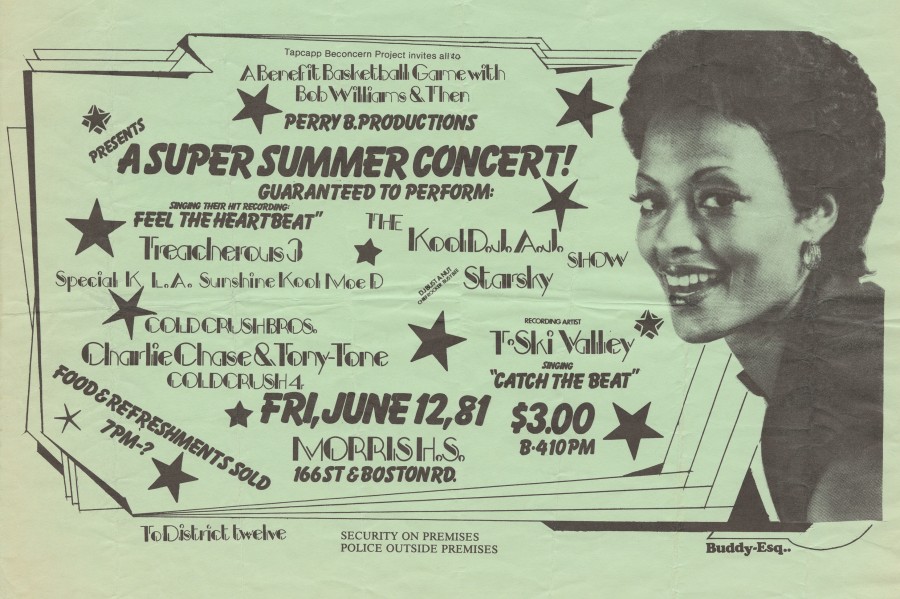Forty years after its birth, hip-hop is everywhere, a global signifier of youthfulness and subversion and opulence and Americanness and blackness and menace, sometimes all at once.
But for all the glorification of hip-hop’s early days in the South Bronx — the brilliant improvisation, the block parties — there isn’t a whole lot of supporting documentation. A lot of what we know is from the fading memories of aging b-girls and b-boys who were present at the creation.
Some of the most important surviving documents from that period were the party flyers. You may remember the story our colleagues at NPR music did on the party where hip-hop was born and the flyer advertising the jam at 1520 Sedgwick Avenue at a cost of 25 cents for the “ladies” and 50 cents for the “fellas.” That flyer consisted of some scribbled writing on lined paper.
The party flyers of Lemoin Thompson — a.k.a. Buddy Esquire — were much more sophisticated than that. Esquire created more than 300 flyers over a half-decade that were handed out around the neighborhood to advertise the parties. He called his style “neo-deco” — it borrowed heavily from the Art Deco styles of old movie posters. That was on purpose: he wanted to “class up” the proceedings, which were often held in rec rooms and high schools. Esquire told Cornell University graduate student Amanda Lalonde, “That’s what I tried for, you know: give it a level of class even though it was just a ghetto jam.”
He became the preeminent flyer artist of the early days, and after he could no longer afford to store them, an archivist named Johan Kugelberg, purchased the collection and republished them in a book. Taken together, the flyers offer a glimpse into hip-hop’s beta stage, before rappers could get record deals.
Esquire died earlier this month from smoke inhalation after a kitchen accident. He was 55. His funeral drew in all sorts of early hip-hop pioneers.
“Among those wandering in and out of the small funeral home were Afrika Bambaataa, the D.J.; Charlie Ahearn, the film director; and Theodore Livingston, better known as Grandwizzard Theodore, who is said to have invented scratching.
“‘A flyer either made you want to tell everyone about the party, or not go at all,’ said Mr. Livingston, 50, who huddled with former graffiti artists in the back of the funeral home, swapping stories about Mr. Thompson. In the spirit of hip-hop braggadocio, he shut down debate over whether Phase 2, Mr. Thompson’s competitor, may have been better. ‘Buddy. No question,’ Mr. Livingston insisted.
Before the flyers, though, Esquire was a graffiti artist. He started tagging in 1972 — before hip-hop was even a thing and at a time when the police cracked down hard on graffiti artists. But he said it became like an urge he kept succumbing to, even after scrapes with the law and his parents. “[It’s] like an itch a drive to want to do it to want to get better, to want to work hard at it,” he told OldSchoolHipHop.com back in 2010.”Sometimes you do it on a couple of pieces of paper sometimes you just want to go out and write. When that time came and I graduated to the trains and I use to hit the Bay Chester layup. It was a crazy rush tagging inside and outside of the trains. By the early 80′s I was finished.”
All the while, he was creating party flyers, an idea he approached with early hip-hop’s improvisational, autodidactic spirit.
“I went to the library and I took out a book on fine painting, where they talked about letters, proportions and lay outs and stuff like that … So I took a look at the book and I tried drawing some of the letters that were in the book and I said to myself, hey I can do this stuff. [sic] So now what made me go to the library was because when people would put paint on jeans and stuff it was either graffiti or some kind of sloppy looking hand writing [sic]. So I was like figuring let me do it this way and that will make my stuff noticeable.”
He definitely got noticed. In the few years he was active, he made over 300 flyers. And because this is hip-hop, there were always bragging rights at stake.
“There were guys like A. Riley, who was alright,” he told OldSchoolHipHop. He rattled off some more names of his flyer-making contemporaries. “Then there was Danny Tongue who used to do flyers for Flash also, and he was more like an illustrator I think. Then there was Cisco Kid who ran with The Herculords, he made flyers for Charlie Chase.”
But even as he acknowledged them, he felt the need to clarify his place in the pecking order: “I am the King of Flyers! Period.”
9(MDAxNzk1MDc4MDEyMTU0NTY4ODBlNmE3Yw001))

Buddy Esquire was a prolific handbill artist in hip-hop's early days in the South Bronx. This and...

buddy-esq-001.jpg

buddy-esq-0021.jpg

buddy-esq-0041.jpg

buddy-esq-005.jpg

buddy-esq-006.jpg

buddy-esq-007.jpg



